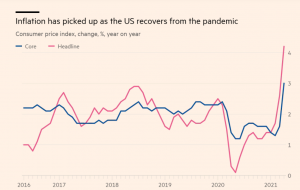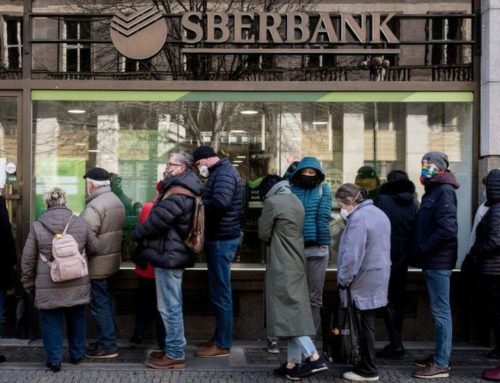Recent economic data in the US, UK and Eurozone suggests that economies are starting to emerge from the effects of the pandemic at a stronger rate and faster pace that was previously expected.
In the US, the economy grew at an annualised rate of 6.4% in the first quarter 2021, up from 4.3% in the final three months of 2020. On a quarter by quarter basis, it grew 1.6% in the first quarter compared to previous three months where it grew 1.1%. The increased growth was partly down to easing anxiety over the pandemic as vaccines have been rolled out across the US, boosting domestic demand and allowing businesses such as restaurants and bars to reopen. The Biden administration has also ushered through two additional rounds of Covid-19 relief money, the most recent of which saw unemployment subsidies extended and qualified households being sent one-off cheques for $1,400.
Despite this return of growth the rate of unemployment in the US has been falling slowly and it still remains way above the pre-pandemic levels. Fed chairman Jerome Powell has acknowledged that there were clear signs of progress in the economy but has warned that the recovery is “uneven and far from complete”.
The US is currently stuck with excess liquidity in the system, which stems in part from the Fed’s Asset Purchase programme, in which it buys up $120 Bn of US debt a month. The large amounts of uninvested cash have made their way back to the Fed with demand for the Fed’s reverse repo facility surging and has led to the Fed Funds rate to trade at 0.06%, well below the mid-point of Fed target rate of 0% – 0.25%.
So in the short term, despite the US economy showing a return of growth, the pace is currently not enough for the Fed to start considering increasing the Fed Funds rate.
A by-product of the return to strength in the US economy has been higher commodity and energy prices which have led to a spike in the US level of inflation. The latest reading showing headline prices (as measured by the consumer price Index) increasing by 4.2% in the 12 months to April, up from a reading of 2.6% in March.

The Fed has already announced at last year’s Jackson Hole Symposium that it is prepared to allow inflation to run above its target rate of 2% for a period without resorting to monetary tightening and several economists see the latest increase as temporary.
So the trick for the Fed is to not let inflation run away without taking the necessary measures to cool the economy and initially it will reduce the level of QE before it resorts to tightening.
The length of time that the Fed allows the economy to run ‘hot’ the more evidence of inflation appears.
In the UK, there is an increasing speculation that the next move in interest rates will be up after the BoE sharply upgraded its economic forecasts in its quarterly Monetary Policy Report in May. Markets are now forecasting a rise in the base rate to 0.35% by mid 2023 with another quarter-point increase to 0.60% expected before the end of 2024.
The BoE’s new range of forecasts predicts that GDP will grow by 7.25% this year – the fastest growth since 1941 – as consumer spending soars on the back of an estimated £200 billion of lockdown savings and as businesses start to invest.
The combination of the speed of the recovery and higher commodity prices are expected to drive inflation above the BoE’s target range of between 2.00% to 2.50% for a period of almost a year before it settles back. Rising inflation and the pace of the UK’s bounce-back appear to have ended the chance of negative interest rates being introduced in the foreseeable future. Independent economists have added that the BoE was more likely to begin any policy tightening by selling down the £895 billion of bonds held through quantitative easing.
Last week’s release of the latest Purchasing Managers Index (PMI) figures have backed up the BoE’s findings showing a much stronger economy than was previously forecast.

The composite PMI rose to 62.0 in May from 60.7 in April, with the services sector (which makes up 80% of the UK economy) increasing to 61.8 from 61.0 in April, and the manufacturing sector increasing to 66.1 from 60.9 a month earlier.
Retail sales in April have also recovered showing a 9.2% increase in May from April against an expected increase of 4.5%.

CPI inflation in the UK rose in April to 1.5% from 0.7% in March, still below the target rate of 2.0%, but BOE Governor Andrew Bailey has said that the UK would not tolerate a persistent overshoot of the 2% target. The BOE has forecast that it expects to see an inflation overshoot later this year to 2.5% before falling back to 2% in 2022, as the UK’s fiscal support package falls away.
The UK base rate, which was facing a potential move to negative territory last December, is now expected to remain unchanged for the rest of 2021 and first half of 2022. Thereafter gradual tightening is expected.
In the Eurozone, the European Commission has sharply raised its economic forecasts for the next two years and is now predicting growth in the Eurozone of 4.3% in 2021 and 4.4% in 2022, compared to previous estimates of 3.8% in both years. As a result, all member states are expected to regain their pre-covid levels by the end of the year. The stronger growth was driven by the rising vaccination rates and prospect of lockdowns easing across the region, as well as improved export demand. The recent forecasts take into account the e800Bn Next Generation EU economic relaunch package which is expected to be paying out in the second half of the year.
Spain which was the hardest hit EU economy last year, losing more that 10% of output , is expected to grow 5.9% in 2021 and 6.8% in 2022.Italy is set to expand 4.2% this year and 4.4% next. Germany which had a much smaller contraction in 2020, is expected to grow 3.4% in 2021 and 4.1% in 2022.
The cost of the crisis will see the overall eurozone deficit rise 8% of GDP this year falling to 4% for 2022, but the overall euro debt-to GDP ration will be above 100% this year and next.
Each of the economies are now facing the tricky decision as to when to start paring back economic support. Too early risks sending the recovery into reverse but too late risks higher than targeted inflation.
The continued roll out of vaccines, the rate of inflation and the level of consumer expenditure will be watched closely for the rest of 2021, as any quicker forecast drawing down on consumer savings or persistent overshoot in the inflation rate, will lead to speculation that central banks will be forced to increase short term rates sooner than currently forecast.
Graphs sourced from FT.com


